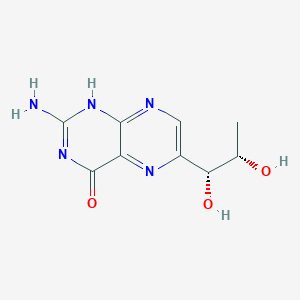| General Information of MET (ID: META00779) |
| Name |
Biopterin
|
| Synonyms |
Click to Show/Hide Synonyms of This Metabolite
(-)-Biopterin', (1'r,1's) Biopterin, '2-Amino-6-(L-erythro-1,2-dihydroxypropyl)-4(3H)-pteridinone; 2-Amino-6-(1,2-dihydroxypropyl)-4(1H)-pteridinone; 6-Biopterin; Biopterin; Dictyopterin; L-Biopterin; L-Erythro-biopterin; Orinapterin; Pterin H b2; [S-(R*,s*)]-2-amino-6-(1,2-dihydroxypropyl)-4(1H)-pteridinone
|
| Source |
Endogenous;Food
|
| Structure Type |
Pterins and derivatives (Click to Show/Hide the Complete Structure Type Hierarchy)
Organoheterocyclic compounds
Pteridines and derivatives
Pterins and derivatives
|
| PubChem CID |
|
| HMDB ID |
|
| Formula |
C9H11N5O3
|
| Structure |
<iframe style="width: 300px; height: 300px;" frameborder="0" src="https://embed.molview.org/v1/?mode=balls&cid=445040"></iframe>
|
 |
|
3D MOL
|
2D MOL
|
|
Click to Show/Hide the Molecular/Functional Data (External Links/Property/Function) of This Metabolite
|
| KEGG ID |
|
| ChEBI ID |
|
| FooDB ID |
|
| ChemSpider ID |
|
| METLIN ID |
|
| Physicochemical Properties |
Molecular Weight |
237.2153 |
Topological Polar Surface Area |
N.A. |
| XlogP |
N.A. |
Complexity |
N.A. |
| Heavy Atom Count |
N.A. |
Rotatable Bond Count |
N.A. |
| Hydrogen Bond Donor Count |
N.A. |
Hydrogen Bond Acceptor Count |
N.A. |
| Function |
Biopterin concentrations in cerebrospinal fluid from patients with Parkinson's disease, in which the nigrostriatal dopamine neurons degenerate, are lower than those from age-matched older controls. In hereditary progressive dystonia/DOPA-responsive dystonia, which is a dopamine deficiency caused by mutations in GTP cyclohydrolase I without neuronal cell death (Segawa's disease), neopterin and biopterin in cerebrospinal fluid decrease in parallel owing to the decreased activity in GTP cyclohydrolase I. GTP cyclohydrolase I (EC 3.5.4.16) is an enzyme that is part of the folate and biopterin biosynthesis pathways. It is responsible for the hydrolysis of guanosine triphosphate (GTP) to form 7,8-dihydroneopterin 3'-triphosphate. (Pteridines (1999), 10(1), 5-13.) Lowered levels of urinary biopterin concomitant with elevated serum phenylalanine concentration occur in a variant type of hyperphenylalaninemia caused by a deficiency of tetrahydrobiopterin (BH4), the obligatory cofactor for phenylalanine hydroxylase. The most frequent form of this cofactor deficiency is due to lack of 6-pyruvoyl-tetrahydropterin synthase (PTPS) activity, the second enzyme in the biosynthetic pathway for BH4. The hepatic phenylalanine hydroxylating system consists of 3 essential components, phenylalanine hydroxylase, dihydropteridine reductase, and the nonprotein coenzyme, tetrahydrobiopterin. The reductase and the pterin coenzyme are also essential components of the tyrosine and tryptophan hydroxylating systems. There are 3 distinct forms of phenylketonuria or hyperphenylalaninemia, each caused by lack of 1 of these essential components. The variant forms of the disease that are caused by the lack of dihydropteridine reductase or tetrahydrobiopterin are characterized by severe neurol. deterioration, impaired functioning of tyrosine and tryptophan hydroxylases, and the resultant deficiency of tyrosine- and tryptophan-derived monoamine neurotransmitters in brain.
|
|
Regulatory Network
|
|
|
|
|
|
|
|
|
 click to show the details of this protein
click to show the details of this protein
 click to show the details of experiment for validating this pair
click to show the details of experiment for validating this pair

